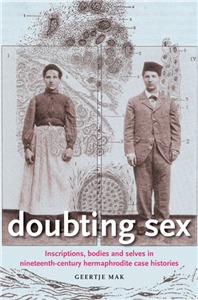Doubting sex
Inscriptions, bodies and selves in nineteenth-century hermaphrodite case histories
by Geertje Mak
An adolescent girl is mocked when she takes a bath with her peers, because her genitals look like those of a boy. A couple visits a doctor asking to 'create more space' in the woman for intercourse. A doctor finds testicular tissue in a woman with appendicitis, and decides to keep his findings quiet. These are just a few of the three hundred European case histories of people whose sex was doubted during the long nineteenth century that Geertje Mak draws upon in her remarkable new book. How did people deal with such situations? How did they decide to which sex a person should belong? This groundbreaking analysis of clinical case histories shows how sex changed from an outward appearance inscribed in a social body to something to be found deep inside body and self. A fascinating, easy to follow, yet sophisticated argument addressing major issues of the history of body, sex, and self, this volume will fit advanced undergraduate courses, while challenging specialists.









